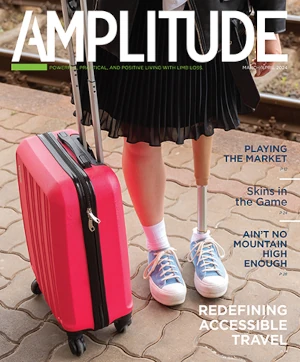
Photograph of Hichert by Jos Wassink, courtesy of TU Delft.
Mona Hichert, MSc, a biomechanical engineer and doctoral candidate from Delft University of Technology (TU Delft), Netherlands, has been researching body-powered prosthetic arms since 2011, with a focus on why so many users eventually abandon their use. Rejection rates are reported at 26-45 percent. One reason for rejection is that the high force needed to operate the hand causes fatigue, irritation, or pain, and the most hand-like prostheses require greater operation forces than hooks. To this end, Hichert has written a thesis on the improvement of body-powered prostheses, which offer several advantages compared to myoelectric prostheses, such as being lighter weight, less expensive, and more reliable, and they offer the user extended proprioceptive feedback about the prehensor’s movements and exerted grip force.
Tests with a representative group of 23 prosthesis users showed that men can deliver more force than women and that the spread is quite large. The average force for men is 332 ± 117 newtons and for women 188 ± 87 newtons. “The wide range of measured forces indicates that clinicians need to evaluate each individual’s capacity to operate an available body-powered prosthesis based on his strength,” Hichert concluded.
Hichert compared the force that users can routinely provide with forces needed to handle various prostheses. Guidelines say that the routine force is 20 percent of the maximum. However, the results show that, depending on the device, 26-100 percent of the users cannot use active closing devices without fatigue. Actively opening prehensors score even worse, with 52-91 percent of the users experiencing fatigue or irritation, depending on the device.
Regarding cable operation forces required to control grip effectively, Hichert found that a long operation movement stroke, and thus a large cable excursion, contributes to increased prehensor control. In addition, for the suggested low operation force levels, the Ipsilateral Scapular Cutaneous Anchor System provides a good alternative for the traditional harness.
Engineers should do a better job in designing prostheses that require less force to operate, Hichert advised. Equally, clinicians should only recommend devices that their patients can routinely use, based on individual strength measurements.
Editor’s note: This story was adapted from materials provided by TU Delft.



